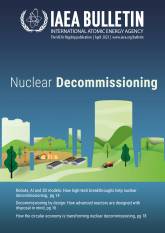Q: What are some of the implementation challenges faced by the UP2-400 decommissioning project and how do they compare to the decommissioning of other major nuclear facilities, such as NPPs?
A: The main challenge faced by the UP2-400 decommissioning project is the presence of radioactive deposits and contamination in a vast proportion of the shut-down facilities. In an NPP, the removal of spent fuel and a full system decontamination removes more than 99 per cent of the initial radioactivity present in the NPP. Only the reactor pressure vessel and its internal equipment are still significantly radioactive. In a reprocessing plant such as UP2-400, it is a little different. Each piece of equipment and each room is contaminated with a level of radioactivity, and these components need to be retrieved and conditioned before dismantling can take place. This means that the reprocessing plant’s safety functions need to be preserved during most of the decommissioning project, whereas in NPPs, safety classes and systems can be reduced once defuelling is complete and the spent fuel pool has been emptied.
Q: What are the main operational and strategic decommissioning risks facing the project and what is being done to manage them?
A: The main strategic risks are cost overruns and delays in completing the project, since delays generate additional costs. Delays can be caused by a variety of operational risks covering all aspects of the project. The two most significant are, firstly, a lack of knowledge concerning the initial radiological condition of the high activity cells and equipment; and, secondly, challenges related to career development and staff retention. To mitigate the first risk, we have pursued a very comprehensive characterization programme that significantly reduces uncertainty concerning the condition of the reprocessing plant and its cells for several years. In the meantime, we have tried to manage the human resources challenge with a range of actions, including involvement in regional and national training programmes, a proactive recruitment policy, the continuous training of our staff to facilitate versatility and mobility in the organization, and innovation in decommissioning practices to improve the working environment.







